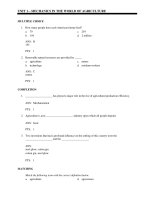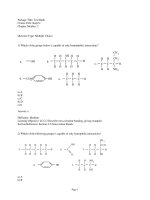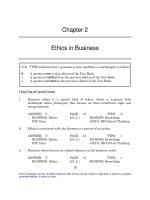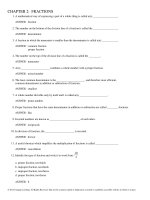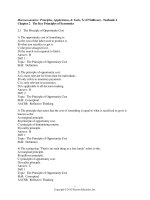Fundamentals of investments valuation and management 7th edition jordan test bank
Bạn đang xem bản rút gọn của tài liệu. Xem và tải ngay bản đầy đủ của tài liệu tại đây (596.1 KB, 94 trang )
Chapter 02
The Investment Process
Multiple Choice Questions
1.
Market timing is the:
A. placing of an order within the last half-hour of trading for a day.
B. period of time between the placement of a short sale and the covering of that sale.
C. buying and selling of securities in anticipation of the overall direction of the market.
D. staggering of either buy or sell orders to mask the total size of a large transaction.
E. placing of trades within the last half-hour prior to the commencement of daily trading.
2.
Asset allocation is the:
A. selection of specific securities within a particular class or industry.
B. division of a purchase price between a cash payment and a margin loan.
C. division of a portfolio into short and long positions.
D. distribution of investment funds among various broad asset classes.
E. dividing of assets into those that are hypothecated and those that are not.
2-1
Copyright © 2015 McGraw-Hill Education. All rights reserved. No reproduction or distribution without the prior written consent of
McGraw-Hill Education.
3.
Jesse is researching chemical companies in an effort to determine which company's stock he
should purchase. This process is known as:
A. market timing.
B. purchase shorting.
C. marketing research.
D. asset allocation.
E. security selection.
4.
A Roth IRA:
A. is a form of "tax-deferred" account
B. funds are taxed at the time you begin withdrawals
C. are well-suited to investors nearing retirement
D. invests after-tax dollars
E. is the type of account offered by most employers
5.
A brokerage account in which purchases can be made using credit is referred to as which type of
account?
A. clearing
B. funds available
C. cash
D. call
E. margin
2-2
Copyright © 2015 McGraw-Hill Education. All rights reserved. No reproduction or distribution without the prior written consent of
McGraw-Hill Education.
6.
Kate just purchased $7,000 worth of stock. She paid $5,000 in cash and borrowed $2,000. In this
example, the term margin refers to:
A. the total amount of the purchase.
B. the percentage of the purchase that was paid in cash.
C. the percentage of the purchase paid with borrowed funds.
D. any future increase in the value of the stock.
E. any future decrease in the value of the stock.
7.
Which one of the following best describes the term "initial margin"?
A. Amount of money that must be deposited to open a margin account with a broker
B. Amount of cash that must be paid to purchase a security on margin
C. Amount of cash that must be paid when a broker issues a margin call
D. Amount of money borrowed when a security is purchased
E. Total loan amount offered to a customer by a brokerage firm to cover future purchases
8.
The minimum equity that must be maintained at all times in a margin account is called the:
A. initial margin.
B. initial equity position.
C. maintenance margin.
D. call requirement.
E. margin call.
2-3
Copyright © 2015 McGraw-Hill Education. All rights reserved. No reproduction or distribution without the prior written consent of
McGraw-Hill Education.
9.
When your equity position in a security is less than the required amount, your brokerage firm will
issue a:
A. margin call.
B. margin certificate.
C. cash certificate.
D. limit order.
E. leverage call.
10. Stuart purchased 300 shares of Microsoft stock which he has pledged to his broker as collateral for
the loan in his margin account. This process of pledging securities is called:
A. margin calling.
B. hypothecation.
C. leveraging.
D. maintaining the margin.
E. street securitization.
11. Staci owns 1,000 shares of stock in a margin account. Those shares are most likely held in:
A. transit.
B. her registered name.
C. street name.
D. a wrap account.
E. a discretionary account.
2-4
Copyright © 2015 McGraw-Hill Education. All rights reserved. No reproduction or distribution without the prior written consent of
McGraw-Hill Education.
12. This morning, Josh sold 800 shares of stock that he did not own. This sale is referred to as a:
A. margin sale.
B. long position.
C. wrap trade.
D. hypothecated sale.
E. short sale.
13. The amount of common stock held in short positions is referred to as the short:
A. margin.
B. shares.
C. proceeds.
D. sale.
E. interest.
14. A company that owns income-producing real estate such as an apartment complex or a retail
shopping center is called a(n):
A. REIT.
B. SIPC.
C. REEF.
D. EAR.
E. SPIC.
15. An investor who has a resource constraint:
A. pays no income taxes.
B. has insufficient funds to purchase a security.
C. has a relatively high marginal tax rate.
D. has only one source of income.
E. will only invest in socially acceptable securities.
2-5
Copyright © 2015 McGraw-Hill Education. All rights reserved. No reproduction or distribution without the prior written consent of
McGraw-Hill Education.
16. To be considered liquid, a security must:
A. be held in a cash account.
B. pay dividends.
C. be able to be sold on short notice.
D. be held for less than one year.
E. be able to be sold quickly with little, if any, price concession.
17. Wythe is trying to decide whether he wants to purchase shares in General Motors, Ford, or Honda,
all of which are auto manufacturers. Wythe is making a(n) _____ decision.
A. security selection
B. tax-advantaged
C. risk aversion
D. active strategy
E. asset allocation
18. Brooke has decided to invest 55 percent of her money in large company stocks, 40 percent in
small company stocks, and 5 percent in cash. This is a(n) _____ decision.
A. market timing
B. security selection
C. tax-advantaged
D. active strategy
E. asset allocation
2-6
Copyright © 2015 McGraw-Hill Education. All rights reserved. No reproduction or distribution without the prior written consent of
McGraw-Hill Education.
19. Kay plans to retire in two years and wishes to liquidate her account at that time. Kay has a _____
constraint.
A. resource
B. horizon
C. liquidity
D. tax
E. special circumstances
20. The SIPC:
A. guarantees investors against any loss related to an investment account held at a brokerage firm.
B. guarantees cash balances held in brokerage accounts up to $500,000.
C. is an agency of the federal government.
D. protects private brokerage firms from bankruptcy.
E. protects investors from missing assets when a brokerage firm closes.
21. The determination of which individual stocks to purchase within a particular asset class is referred
to as:
A. security selection.
B. asset allocation.
C. security analysis.
D. market timing.
E. market selection.
2-7
Copyright © 2015 McGraw-Hill Education. All rights reserved. No reproduction or distribution without the prior written consent of
McGraw-Hill Education.
22. An investor who follows a fully active strategy will:
A. move money between asset classes as well as try to select the best performers in each class.
B. move money between asset classes but will not be concerned about which individual securities
are owned.
C. focus on picking individual stocks only.
D. maintain a relatively constant mix of asset classes while continually buying and selling individual
securities.
E. concentrate solely on asset allocation to maximize potential returns.
23. Which one of the following decisions falls under the category of asset allocation?
A. Purchasing Ford stock rather than General Motors stock
B. Determining that thirty percent of a portfolio should be invested in bonds
C. Adopting a passive investment strategy
D. Deciding to actively analyze individual securities
E. Deciding to use an online broker
24. Ted recently inherited a large sum of money that he wants to invest in the stock market. Since he
has no investment experience, he has decided that he would like to work with a professional who
can explain the market to him and also manage his funds for him. Ted most likely needs the
services offered by a(n):
A. deep-discount broker.
B. discount broker.
C. full-service broker.
D. online broker.
E. cyberbroker.
2-8
Copyright © 2015 McGraw-Hill Education. All rights reserved. No reproduction or distribution without the prior written consent of
McGraw-Hill Education.
25. Which one of the following statements is correct?
A. Most brokerage agreements require disputes be settled in a court of law.
B. Arbitration is a formal legal process for settling disputes related to brokerage accounts.
C. Churning is the preferred method of providing deep-discount brokerage services.
D. Discount brokers only provide order execution services.
E. Full service brokers frequently provide financial planning services to clients.
26. Martin has an investment account with William, who is a broker with City Brokerage. Martin
believes that William has mishandled his account by churning it. If he files a complaint against
William seeking compensation, the case will most likely be decided by:
A. the office manager of City Brokerage.
B. a civil suit judge.
C. a jury.
D. an arbitration panel.
E. the SEC Hearing Board.
27. You currently have $5,000 in cash in your brokerage account. You decide to spend $8,000 to
purchase shares of stock and borrow $3,000 from your broker to do so. Which type of brokerage
account do you have?
A. Cash
B. Wrap
C. Margin
D. Short
E. Asset allocation
2-9
Copyright © 2015 McGraw-Hill Education. All rights reserved. No reproduction or distribution without the prior written consent of
McGraw-Hill Education.
28. Which one of the following statements is correct?
A. The call money rate is the rate of interest brokerage firms charge on margin loans.
B. The spread is the fee a deep-discount broker charges to execute a trade.
C. The percentage of a purchase paid for with borrowed funds is referred to as the margin.
D. A margin loan is treated as an asset on an account balance sheet.
E. Margin is equal to account equity divided by the value of the securities owned.
29. Staci just used $6,000 of cash plus a $3,000 margin loan to purchase $9,000 worth of stock. This is
the only transaction in her brokerage account. According to her account balance sheet, she now
has account equity of:
A. $3,000.
B. $6,000.
C. $9,000.
D. $12,000.
E. $15,000.
30. Amy just purchased $12,000 of stock. She paid $9,000 in cash and borrowed the remaining $3,000
needed to pay for this purchase. If you constructed a balance sheet reflecting this transaction, the
total assets would be:
A. $3,000.
B. $9,000.
C. $12,000.
D. $15,000.
E. $21,000.
2-10
Copyright © 2015 McGraw-Hill Education. All rights reserved. No reproduction or distribution without the prior written consent of
McGraw-Hill Education.
31. Anita wants to buy $10,000 of securities in her margin account. Her advisor has informed her that
she must pay a minimum of $7,000 in cash and maintain a minimum equity position of 30 percent.
The initial margin requirement is _____ percent and the maintenance margin is _____ percent.
A. 30; 30
B. 30; 70
C. 70; 30
D. 70; 50
E. 70; 70
32. The absolute minimum initial margin requirement is set by the:
A. individual investor.
B. brokerage firm.
C. Federal Reserve.
D. Security Investors Protection Corporation.
E. Securities and Exchange Commission.
33. You open a margin account with a local broker and purchase shares of stock. The house
maintenance margin requirement for your account is set by:
A. your broker.
B. the stock exchange.
C. the SEC.
D. the SIPC.
E. the Federal Reserve.
2-11
Copyright © 2015 McGraw-Hill Education. All rights reserved. No reproduction or distribution without the prior written consent of
McGraw-Hill Education.
34. If you opt to purchase shares of stock on margin rather than with cash, you will:
A. decrease your maximum potential rate of return.
B. increase your maximum potential rate of return.
C. guarantee yourself a profit.
D. eliminate any potential profit.
E. have equal rates of return regardless of how the purchase is made.
35. What is the purpose of a margin call?
A. to inform you that your margin loan is due and payable
B. to demand funds to increase your margin position
C. to let you know the amount of funds that are now available for you to borrow
D. to advise you that the interest rate on your loan has changed
E. to remind you of the upcoming monthly payment due on your margin loan
36. If you ignore a margin call, your broker:
A. will seize all the assets in your account.
B. will close your account.
C. may place a short sale on your behalf to cover the amount of the call.
D. may sell some of your securities to repay the margin loan.
E. will increase both your margin loan and the rate of interest on that loan.
2-12
Copyright © 2015 McGraw-Hill Education. All rights reserved. No reproduction or distribution without the prior written consent of
McGraw-Hill Education.
37. Lauren Mitchell has a margin account with a local brokerage firm, RL Brokers. She recently
purchased 200 shares of Abbot Industries common stock that trades on the New York Stock
Exchange (NYSE). These shares are held in street name and are registered under the name of:
A. Lauren Mitchell.
B. RL Brokers.
C. Abbot Industries.
D. the New York Stock Exchange.
E. the Securities and Exchange Commission.
38. Which one of the following is generally true concerning securities held in street name?
A. The securities are registered under your mailing address rather than your name.
B. There is a greater likelihood the security may be stolen.
C. All dividend checks are mailed to your street address.
D. The annual stock report is mailed directly to your street address.
E. The brokerage firm is the owner of record.
39. Sarah has a brokerage account with Jeff, who is a money manager with Downtown Brokers. Sarah
pays an all-inclusive annual fee to the firm and Jeff manages her funds. She pays no trading costs
or commissions. Which one of the following best describes this type of account?
A. wrap
B. cash
C. margin
D. mutual
E. advisory
2-13
Copyright © 2015 McGraw-Hill Education. All rights reserved. No reproduction or distribution without the prior written consent of
McGraw-Hill Education.
40. A discretionary account:
A. authorizes a broker to trade securities on your behalf.
B. charges an annual fee to cover all trading and management services.
C. is the term applied to brokerage accounts with check-writing and credit card services.
D. is the same as a wrap account.
E. is the account used to pledge securities as collateral for a margin loan.
41. An investor with a long position in a security will make money:
A. if the price of the security increases.
B. if the price of the security declines.
C. if the price of the security remains stable.
D. only if the security has been purchased on margin.
E. only by shorting the security.
42. Which one of the following describes a short position?
A. Purchasing a security on margin
B. Selling a security that you originally purchased on margin
C. Loaning a security to your broker to cover a margin call
D. Having less equity than required in your margin account
E. Selling a security that you do not own
2-14
Copyright © 2015 McGraw-Hill Education. All rights reserved. No reproduction or distribution without the prior written consent of
McGraw-Hill Education.
43. On August 8 of this year, Brent sold 500 shares of ADO stock for $24 a share. On September 6 of
this year, he purchased 500 shares of ADO stock to cover his position. The transaction on August
8:
A. was a short sale.
B. was a margin trade.
C. was a wrap transaction.
D. created a long transaction.
E. was a pooling transaction.
44. A short sale:
A. creates a long position in a stock.
B. involves the borrowing of securities.
C. is the purchase of less than 100 shares of a stock.
D. is a bullish outlook towards a security.
E. is the resale of a security within four hours of purchase.
45. If you benefit when a security decreases in value, you have a _____ position in the security.
A. long
B. margined
C. short
D. covered
E. wrapped
2-15
Copyright © 2015 McGraw-Hill Education. All rights reserved. No reproduction or distribution without the prior written consent of
McGraw-Hill Education.
46. The maximum loss you can incur on a short sale is:
A. limited to your initial equity.
B. limited to your initial margin.
C. limited to the margin loan plus interest.
D. zero.
E. unlimited.
47. What is the maximum loss you can incur if you have a long position on a stock in a cash account?
A. The initial investment
B. The initial margin
C. The margin loan plus interest
D. Zero
E. Unlimited
48. Taylor Industries stock is selling for $26 a share. You would like to purchase as many shares of this
stock as you can. Your margin account currently has available cash of $4,700 and the initial margin
requirement is 60 percent. What is the maximum number of shares you can buy?
A. 193 shares
B. 287 shares
C. 301 shares
D. 360 shares
E. 408 shares
2-16
Copyright © 2015 McGraw-Hill Education. All rights reserved. No reproduction or distribution without the prior written consent of
McGraw-Hill Education.
49. Todd has a margin account with $17,400 in available cash. The initial margin is 70 percent and the
maintenance margin is 30 percent. What is the maximum number of shares he can purchase if the
price per share is $44?
A. 395 shares
B. 564 shares
C. 698 shares
D. 744 shares
E. 842 shares
50. Theresa has a margin account with a 60 percent initial margin requirement and a 35 percent
maintenance margin. What is the maximum dollar amount of stock she can purchase if her cash
balance in the account is $35,300?
A. $19,140.00
B. $31,900.00
C. $44,093.33
D. $58,833.33
E. $91,142.86
51. You recently purchased 900 shares of Western Timber stock for $38 a share. Your broker required
a cash payment of $25,650, plus trading costs, for this purchase. What was the initial margin
requirement?
A. 60 percent
B. 65 percent
C. 70 percent
D. 75 percent
E. 80 percent
2-17
Copyright © 2015 McGraw-Hill Education. All rights reserved. No reproduction or distribution without the prior written consent of
McGraw-Hill Education.
52. Donna recently purchased 500 shares of Deltona stock for $33.00 a share. Her broker required a
cash payment of $10,725, plus trading costs, for the purchase. What is the initial margin
requirement on this particular stock?
A. 60 percent
B. 65 percent
C. 75 percent
D. 80 percent
E. 90 percent
53. Suzette recently purchased 300 shares of Nu Electronics stock for $4.40 a share. Her broker
required a cash payment of $1,320, plus trading costs, for the purchase. What is the initial margin
requirement on this stock?
A. 70 percent
B. 75 percent
C. 80 percent
D. 90 percent
E. 100 percent
54. Stephen is purchasing 700 shares of KPT, Inc., stock at a price per share of $28.00. What is the
minimum amount the Federal Reserve will require Stephen to pay in cash for this purchase?
A. $4,488
B. $7,480
C. $9,800
D. $10,968
E. $11,960
2-18
Copyright © 2015 McGraw-Hill Education. All rights reserved. No reproduction or distribution without the prior written consent of
McGraw-Hill Education.
55. Alfonso purchased 600 shares of Crosswinds, Inc., stock on 60% margin when the stock was selling
for $37 a share. The stock is currently selling for $32 a share. What is his current equity position?
A. $7,680
B. $8,880
C. $9,600
D. $10,320
E. $11,560
56. You purchased 1,000 shares of stock at $42 a share. The stock is currently selling for $45 a share.
The initial margin was 70 percent and the maintenance margin is 30 percent. What is your current
margin position?
A. 28.36 percent
B. 25.00 percent
C. 75.00 percent
D. 63.59 percent
E. 72.00 percent
57. You own 700 shares of a stock that you purchased on margin at a price per share of $20.12. The
stock is currently valued at $23 a share. Your broker advised you today that your minimum equity
position for this purchase is $5,635 as of today. What is the maintenance margin percentage?
A. 25 percent
B. 30 percent
C. 35 percent
D. 40 percent
E. 50 percent
2-19
Copyright © 2015 McGraw-Hill Education. All rights reserved. No reproduction or distribution without the prior written consent of
McGraw-Hill Education.
58. Sun Lee purchased 1,500 shares of Franklin Metals stock for $16.80 a share. The stock was
purchased with an initial margin of 65 percent. The maintenance margin is 30 percent. The stock is
currently selling for $17.10 a share. What is the minimum dollar amount of equity that he must
have in this stock today to avoid a margin call?
A. $7,544
B. $7,695
C. $7,760
D. $7,808
E. $7,973
59. Rosita purchased 300 shares of a stock for $37 a share. Today, the stock is selling for $41 a share.
The initial margin requirement is 70 percent and the maintenance margin is 30 percent. Rosita had
to pay _____ in cash to purchase the stock and must have at least _____ in equity today.
A. $3,690; $3,330
B. $3,690; $3,690
C. $7,770; $3,330
D. $7,770; $3,690
E. $8,610; $3,690
60. Allan purchased 800 shares of stock on margin for $31 a share and sold the shares five months
later for $33.50 a share. The initial margin requirement was 65 percent and the maintenance
margin was 30 percent. The interest rate on the margin loan was 7.5 percent. He received no
dividend income. What was his holding period return?
A. 7.05 percent
B. 8.45 percent
C. 9.88 percent
D. 10.76 percent
E. 11.82 percent
2-20
Copyright © 2015 McGraw-Hill Education. All rights reserved. No reproduction or distribution without the prior written consent of
McGraw-Hill Education.
61. Tony purchased 100 shares of T-Rex stock for $43 a share. On the same day, Sam also purchased
100 shares of T-Rex stock for $43 a share. Tony paid cash for his purchase while Sam used margin.
The initial margin requirement on this stock is 60 percent while the maintenance margin is 40
percent. Both Tony and Sam sold their shares after eight months at a price of $40 a share. The
stock pays no dividends. Tony had a holding period percentage return of _____ percent as
compared to Sam's _____ percent return. Ignore margin interest and trading costs.
A. -4.19; -6.98
B. -4.19; -11.63
C. -6.98; -4.19
D. -6.98; -11.63
E. -11.63; -7.56
62. Stacy purchased 400 shares of stock for $38 a share. She sold those shares six months later for $34
a share. The initial margin requirement is 80 percent and the maintenance margin is 40 percent.
Ignore margin interest and trading costs. If she purchased the shares for cash her holding period
return would be _____ percent as compared to _____ percent if she had used margin.
A. -10.12; -12.84
B. -10.53; -13.16
C. -11.63; -14.30
D. -11.63; -14.54
E. -12.27; -15.82
2-21
Copyright © 2015 McGraw-Hill Education. All rights reserved. No reproduction or distribution without the prior written consent of
McGraw-Hill Education.
63. A stock was purchased for $51 a share and sold eleven months later for $54 a share. If the shares
were purchased totally with cash the holding period return would be _____ percent as compared to
_____ percent if the purchase was made using 70 percent margin. Ignore trading costs and margin
interest.
A. 5.56; 3.89
B. 5.56; 7.94
C. 5.88; 4.12
D. 5.88; 6.69
E. 5.88; 8.40
64. You purchased a stock for $18.45 a share using 70 percent margin. You sold the stock seven
months later for $19.85 a share. You did not receive any dividend income. What was your holding
period percentage return on this investment? Ignore trading costs and margin interest.
A. 8.77 percent
B. 9.12 percent
C. 10.84 percent
D. 11.75 percent
E. 12.13 percent
65. Rudolfo purchased 900 shares of stock for $62.20 a share and sold them ten months later for
$64.60 a share. The initial margin requirement on this stock is 75 percent and the maintenance
margin is 40 percent. Ignoring dividends and costs, what is his holding period return?
A. 3.72 percent
B. 3.86 percent
C. 4.54 percent
D. 4.95 percent
E. 5.14 percent
2-22
Copyright © 2015 McGraw-Hill Education. All rights reserved. No reproduction or distribution without the prior written consent of
McGraw-Hill Education.
66. Marti purchased 100 shares of Better Foods stock on margin at a price of $49 a share. The initial
margin requirement is 60 percent and the maintenance margin is 30 percent. What is the lowest
the stock price can go before Marti receives a margin call?
A. $17.00
B. $24.00
C. $28.00
D. $30.00
E. $33.00
67. You purchased 800 shares of stock for $49.20 a share. The initial margin requirement is 65 percent
and the maintenance margin is 35 percent. What is the lowest the stock price can go before you
receive a margin call?
A. $9.27
B. $14.54
C. $17.22
D. $21.88
E. $26.49
68. Aaron purchased 300 shares of a technology stock for $16.80 a share. The initial margin
requirement on this stock is 85 percent and the maintenance margin is 60 percent. What is the
lowest the stock price can go before he receives a margin call?
A. $4.43
B. $5.55
C. $6.30
D. $8.33
E. $10.03
2-23
Copyright © 2015 McGraw-Hill Education. All rights reserved. No reproduction or distribution without the prior written consent of
McGraw-Hill Education.
69. You purchased 700 shares of stock for $54.30 a share. The initial margin requirement is 75 percent
and the maintenance margin is 35 percent. What is the maximum percentage decrease that can
occur in the stock price before you receive a margin call?
A. 35 percent
B. 38 percent
C. 48 percent
D. 57 percent
E. 62 percent
70. Nelson purchased 1,600 shares of stock for $18.75 a share. The initial margin requirement is 70
percent and the maintenance margin is 40 percent. What is the maximum percent by which the
stock price can decline before he receives a margin call?
A. 30 percent
B. 45 percent
C. 50 percent
D. 65 percent
E. 70 percent
71. You purchase 500 shares of stock on margin at a cost per share of $22. The initial margin
requirement is 60 percent. The effective interest rate on the margin loan is 6.4 percent. How much
interest will you pay if you repay the loan in four months?
A. $68.77
B. $91.93
C. $102.16
D. $112.38
E. $117.04
2-24
Copyright © 2015 McGraw-Hill Education. All rights reserved. No reproduction or distribution without the prior written consent of
McGraw-Hill Education.
72. Ina purchased 800 shares of Detroit Motors stock at a price of $55 a share. The initial margin
requirement is 65 percent and the maintenance margin is 30 percent. The effective interest rate on
the margin loan is 4.69 percent. How much margin interest will she pay if she repays the loan in
seven months?
A. $387.29
B. $401.32
C. $417.29
D. $530.42
E. $647.96
73. Today, you are purchasing 100 shares of stock on margin. The purchase price per share is $35. The
initial margin requirement is 70 percent and the maintenance margin is 30 percent. The call money
rate is 4.5 percent and you are charged 1.6 percent over that rate. What will your rate of return be
if you sell your shares one year from now for $37 a share? Ignore dividends.
A. 5.55 percent
B. 6.42 percent
C. 7.18 percent
D. 7.49 percent
E. 8.03 percent
74. Five months ago, you purchased 400 shares of stock on margin. The initial margin requirement on
your account is 60 percent and the maintenance margin is 30 percent. The call money rate is 4.8
percent and you pay 1.85 percent above that rate. The purchase price was $16 a share. Today, you
sold these shares for $18.00 each. What is your annualized rate of return?
A. 26.15 percent
B. 33.35 percent
C. 42.77 percent
D. 56.87 percent
E. 64.64 percent
2-25
Copyright © 2015 McGraw-Hill Education. All rights reserved. No reproduction or distribution without the prior written consent of
McGraw-Hill Education.
